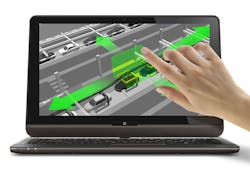In the early days of automotive assembly, when there were no extra amenities offered in the car and therefore no variability on the line, production was a fairly straight-forward process. Today, mass customization in high-volume manufacturing has caused a dramatic shift in assembly plants. Add to that the economic need to consolidate plants—meaning more products are being built on the same line—and the assembly process can turn into a puzzle.
Indeed, the modern assembly line must be flexible and agile in order to manage product variability without introducing waste or compromising quality. And Ubisense Group plc, a provider of enterprise location intelligence technology, is addressing this present-day production problem.
This month, the company introduced the Smart Factory Assembly, a portfolio of manufacturing intelligence applications, real-time location tracking technology, and smart devices that will help automotive manufacturers reduce the cost and complexity of the assembly line.
Based on the company’s existing precise indoor location technology which can track and locate tagged assets to an accuracy of about 15 cm in real-time, Smart Factory Assembly adds operational awareness, adaptive control, and data-driven insights delivered in a virtual system that uncouples the processes from the fixed workstation.
Line balancing can be difficult to do with handheld scanners or passive automatic ID systems and result in the line being stopped if a task is not completed at the end of the workstation. Ubisense’s new Virtual Station operates using virtualized vehicle identification triggers that can be easily added and moved in software, simplifying the need to accommodate new processes or move existing tasks during line rebalancing.
In addition, the new Smart Device creates software-defined zones around a vehicle which constitutes a virtual device control zone. This zone can be used in all of the ways a fixed workstation can be used, for example, controlling the region within which wireless tools can operate. However, software-defined device zones are agile and can accommodate real-time variation, such as varying task duration for different models and moving workstations that allow workers to catch up or work ahead.
“The magic of this is that it is completely adaptable on-the-fly,” says Adrian Jennings, vice president of manufacturing strategy at Ubisense. All cars are different from one another and might have slightly different “bubble” zones, so if a worker needs two extra seconds to complete a job, the virtual workstation provides the time needed to finish the job rather than stop the line. The system can detect the status of a tool, the position of it, and make simple, but intelligent decisions about whether to provide extra space or not.
“In assembly, the process of manufacturing is about motion,” Jennings says. “There is a direct correlation between where you are on the line and where you are in the process, so now, as the car comes into a station, we can ask where in the process is it.” That is what location intelligence is, knowing where in the process vs. where in the building something is, he says.
Ubisense, which started in 2003 with its indoor location technology, moved into the automotive assembly market after being approached by BMW to solve a line issue. Since July, the company has won four major new Smart Factory plants and expanded existing installations at several global vehicle manufacturers including BMW, CLAAS, Cummins, Daimler, Doosan, Honda Motor Company, Hyundai Motor Company, John Deere, Tesla, Toyota and Volkswagen. As a result, sales of its Smart Factory solutions in the second half of 2014 increased by 42% compared to the same period the previous year, the company says.
About the Author
Stephanie Neil
Editor-in-Chief, OEM Magazine

Leaders relevant to this article:
